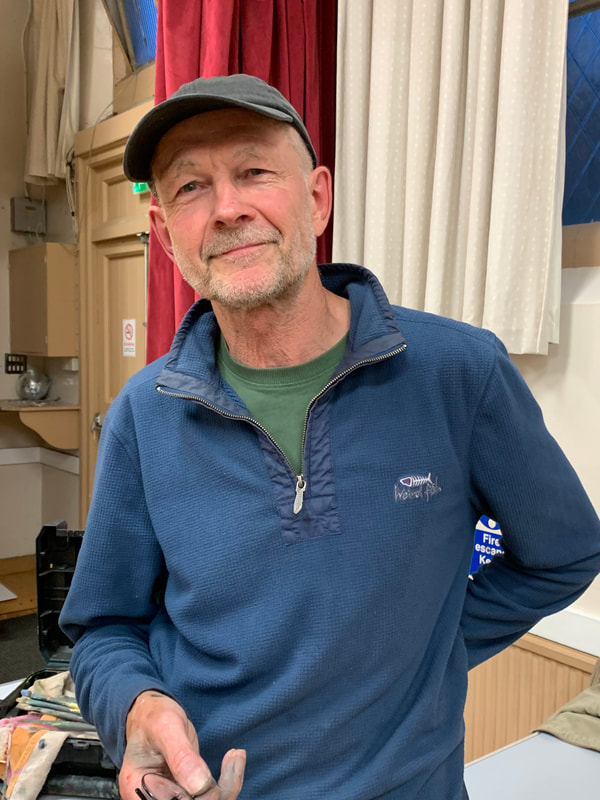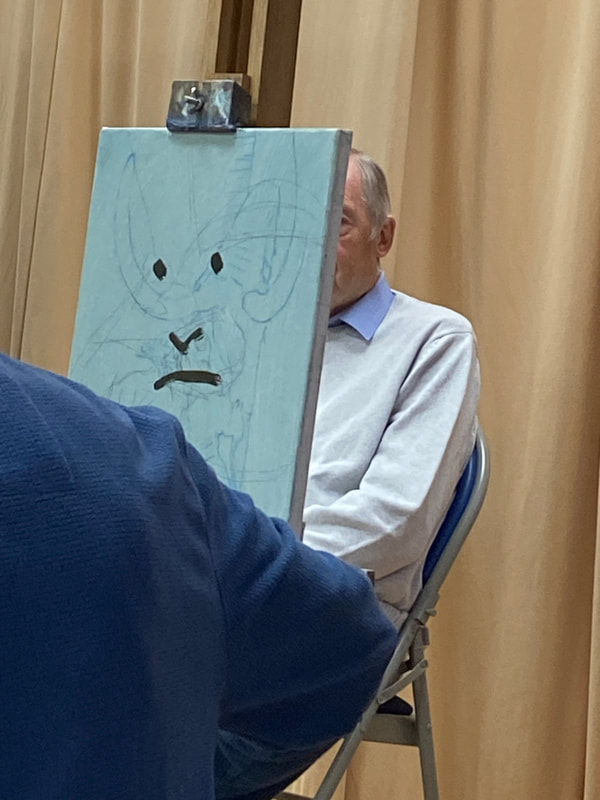|
Demo sheds light on the painter’s technique and approach David Cobley is an English portrait and figure painter, best known for his oil paintings of famous people including actors, royalty, broadcasters, and leaders of large institutions. Luckily for us, David lives in Wiltshire and this demo came about by chance when one of our members, Ken Baldy, attended a talk David gave to a local business group about his life and work. Chatting after the talk Ken asked about doing a demo for us. And the rest, as the saying goes, is history. Held on 5 September at Lacock Village Hall, this demo is our best-attended in recent years, if not ever. The chance to see a painter of such calibre at work proved highly appealing. With about 40 people present, including some visitors, we ran out of chairs so for a few it was standing room only. The aim of the demo was for David to paint a portrait of a ‘live’ sitter, who we could choose, and show how he approaches his craft. Given that Ken instigated the demo it was only fitting that he was David’s muse for the session. David started the demo with a question for the audience; what did we want him to cover during the session? His technique and thinking, was the answer. Equipment With Ken in position sitting on a chair on the hall’s stage, a pale gold curtain as backdrop, and David all set up, he quickly explained about the kit he’s using:
Initial marks He pre-paints a canvas usually with a neutral, greeny blue background, saying that this is partly so as not to feel daunted by a white canvas and it gives a tone to work into. He explains he thinks more in tone than in colour, and this background is 3-4 on the tonal scale where 1 is white and 10 black. David starts the painting by making black marks on the canvas to indicate the position and tonal value of the eyes, nose and mouth, followed by white marks on the forehead, also for tonal purposes. He mixes Prussian Blue (PB) with Venetian Red (VR) to make a darkish grey and advises people to use bigger brushes than you think you need, for faster coverage. Impatient by nature, says David, he likes to see quick results when he paints. The first marks made on the canvas are really important, he says. As he’s never painted Ken before, he doesn’t know what his head looks like so he explores it first. He explains that if this was a normal sitting he would have done some sketches beforehand for exploration. Next he starts thinking about Ken’s head, neck and shoulders and makes a rough outline on the canvas. He also pointed out that, while painting, he constantly flicks his eyes quickly from Ken to canvas and back again, and constantly adjusts the drawing as he goes. He tells us that he has a life size skull at home so is very aware of bone structure and how the flesh falls on a face. Fleshing out Having got the outline down, David changes the paint to Yellow Ochre (YO). He’s now thinking about the contrast of Ken’s pale blue shirt against the warmth of his face and the greeny/blue background so puts YO on the background. For the forehead skin colours he uses a warmer blue than PB, Ultramarine Blue (UMB) and a different brush for each pigment to avoid muddying the colours. Tonally, the forehead is 3 on the scale, he informs us – an overhead light shines on it. He reminds us that the head is asymmetrical so he tends to paint one feature (such as an ear) on one side of the head and checks the corresponding feature on the other side of the face straight away, for accuracy. As he was making adjustments David remarked matter-of-factly that Ken’s neck is thin. Ken retorted, “Well, it’s been wrung a few times!” The audience chuckled loudly, enjoying the banter. Ken pointed out that he’d noticed the high degree of concentration on David’s face when he looks at Ken and back to the canvas. Someone commented that he hadn’t done much to the eyes but nevertheless the likeness is there, just as they are. The best advice he says he’s ever been given came from his school art teacher. He told him to paint what you see, leave your preconceptions at the door. David says he’s conscious the painting looks a mess at this stage, so tries to ignore the messy start and reassure himself that he’s done this before; it will be OK. He need not have worried. Within a mere 20 minutes of starting the painting he had captured a distinct likeness and the essence of Ken. Further refinement After a short tea break we resume. So far he’s used PB, YO, VR for this painting. Responding to a question from the audience about preferred colours, he says he uses PB and VR a lot, but apart from those doesn’t have a standard set of colours as such. Always aware of complementary colours he tries to bring them out in his work, with this painting the colours are orange and blue. Although working from a photo of a subject can sometimes be helpful David says there’s no substitute for a sitting with the person. In portraits you’re trying to create the illusion of a 3D object in space, using pigment and brushes. That’s hard to do from a photo because it’s a flat, 1D surface. Talking as he works, David explains that he’s trying to suggest Ken’s neck is dipping into the collar. More friendly banter ensues. Ken: “Do I look like a tortoise to you?” David: “I think I need my lawyer!” “You’re coming out of your shell, Ken,” quips someone in the audience. As well as painting people David says he loves to get out into countryside and paint the lovely landscape of Wiltshire. He also likes to think, and be controversial in his paintings. Now that he adds more detail and refines the painting he uses thicker paint, which you tend to do as a painting progresses. He adds that using paint straight out of the tube is probably the best approach from a permanence standpoint as it has been mixed specially for this purpose. Asked how to avoid over working or flattening out when painting from a photo, he replies, “Good question. I suppose it’s experience, knowing when to stop.” The session went in a flash and suddenly it was 9pm, time to stop. Feedback from attendees was overwhelmingly positive, saying the demo was “superb”, “amazing”, “fantastic”, “great to listen to – gave us factual information but didn’t overdo it”, “a privilege”, “incredible and inspiring”. Our thanks to David for making it such an enjoyable and interesting evening, and to the art group members who helped to make it all run so smoothly on the night. David spent another hour and a half on the painting the following day; his final version is below. It's interesting to see that the relatively small tweaks and refinements at this stage make such a major difference overall. The painting will soon adorn a wall in Ken’s house, if it doesn't already. David's Devizes exhibition starts soon
David is exhibiting in Devizes, at the White Chalk Gallery, 5 Old Swan Yard, SN10 1AT, from 17 Sept – 5 Oct 2024, Tuesday to Saturday, 10am to 5pm. Called Traces, the exhibition also features ceramics by Janene Waudby. More information is available on David’s website, where you can also buy a copy of his book, All by Himself. It’s a fascinating read, discussing his artistic influences and putting his work into an art historical context by charting his work through key stages of his career.
0 Comments
Leave a Reply. |
WelcomeRead about our latest activities and initiatives here! Archives
February 2025
Categories
All
|
- Home
-
Galleries
- Workshops >
- Challenges >
-
Members' Galleries
>
- Richard Adams
- Ken Baldy
- Keith Bennet
- Graham Brewster
- Victoria Cleverly
- Sarah Clover
- Dave Cooper
- Chris Crosby
- Margaret Gray
- John Harris
- Jacqui Matthews
- Vanda McCann
- Graeme McFaull
- Karen McGreevy
- Glyn Overton
- Sally Parsons
- Linda Ridler
- Karen Road
- Kay Smith
- Joy Tickell
- Jane Tucker
- Elspeth Wales
- Tracy Warne aka Maggie
- Angela Weir Martin
- Mike Wilson
- Exhibitions
- News/Blog
- Membership
- Events
- Contact
Site powered by Weebly. Managed by netnerd.com















 RSS Feed
RSS Feed